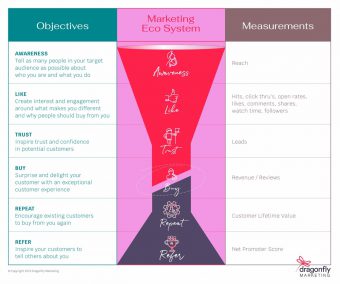As the financial year draws to a close, you may be starting to scrutinise your profit and loss reports in a little more detail. This is the perfect time of year to identify any potential cost savings or revenue earning opportunities for the financial year ahead.
When it comes to assessing your marketing spend, it’s important to review this in line with the return on this investment. How has the money that you spent on tactical marketing activity such as advertising, social media marketing, events etc., helped to increase your bottom line?
Whether your marketing activity has been implemented to achieve short or long term objectives, measuring is the only way that you’ll be able to assess whether your spend has simply cost the business money or whether the investment has contributed to growth.
However, when you are measuring your marketing, don’t be tempted to just review the sales that were realised this financial year. To understand the true impact of your marketing activity, it’s important that you take a much more holistic approach to your marketing measurement.
The reason for this is that there are several steps involved to get a prospective client to buy from you. There is a journey that people must take through what we call a marketing funnel to first of all become aware of your business, secondly get to consider your business and and build trust that your business is the right solution for the problem that they have. Then once they know, like and trust your business or your brand, your prospective client will feel comfortable enough to buy.
And it doesn’t stop there! The cost-efficiencies in getting previous or existing clients to buy more from you versus acquiring new customers are significant. So the next part of our marketing funnel or client journey includes the marketing activities that will help to encourage repeat business and word-of-mouth referrals.
So when you are planning your marketing investment for the financial year ahead, it’s important to assign enough marketing spend to ensure that you are taking prospective clients through the entire marketing journey.
To help you assign your marketing dollars, you’ll firstly need to check back in with your overarching marketing objectives as this will help you determine which step you weight your spending towards.
So for example, if you feel that your business and brand are not very well known in your community, then you might need to weight your spend more towards creating awareness.
If you have a well-known brand and simply need to increase your revenue, then your marketing spend might prioritise activity that drives more conversion or even repeat business from previous or existing clients.
The diagram below illustrates the customer journey in what we have called the ‘Marketing Ecosystem’.

On the left hand side of the diagram is a list of the steps that your client needs to take in order to purchase from you. On the right, you’ll see some suggested measurements that might be used to measure the success of the marketing activity assigned to each stage. You can use this marketing ecosystem as a guide to firstly map out which marketing activity you will put into place for each step of the journey.
So for example to build awareness, you might invest in some print, radio, social media or outdoor advertising. You may even consider investing in some local sponsorship or entering into a marketing partnership to help people get to know your brand.
To help people get to like and trust your brand, you might consider publishing some regular thought leadership content or running some information seminars.
To help drive leads and sales (conversions), you might look at reviewing your website to ensure that it is truly differentiating you from your competitors and giving people a compelling reason to choose your business. Or you may host an event that helps to educate people more about a particular topic and then offer the event attendees a special deal on your services for a limited time only.
To drive repeat sales and encourage word-of-mouth referral, nothing beats an interesting and relevant regular email newsletter sent out to previous and existing clients.
Of course there are many other marketing activities that you can implement to help you take your prospects on this buying journey, however the important thing for your new financial year planning is to make sure that you are forecasting enough marketing investment to address each step. There’s not a lot of point creating an abundance of awareness about your business if you are not catering for how you’ll convert this awareness. Similarly, there is no point being ready for the conversion, if there are simply just not enough people that know about your business to begin with.
And if you are looking for a guideline for what your total marketing spend should be, we tend to work with around 10% of your projected revenue if you have really aggressive growth goals to achieve. However, if you are simply aiming to maintain a consistent presence in the marketplace, then we would suggest forecasting between 3-5% of your projected revenue.
A considered marketing investment will drive a return for your business, so use this time before 1 July to ensure that when it comes to this time next year, you can see exactly how your marketing spend has contributed to the growth of your business both in the short and long term.
To learn more about how to grow your small business with strategic and clever marketing solutions that deliver results, listen to; The How to do Marketing Show – a no-nonsense podcast about small business marketing.






